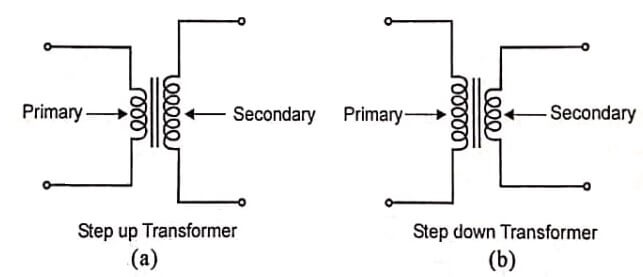Transformer works on the principle of electromagnetic induction. A transformer is an electrical device, having no moving parts, which by mutual induction transfers electric energy from one circuit to another at the same frequency, usually with changed values of voltage and current. It consists of two windings insulated from each other and wound on a common core made up of magnetic material.
Alternating voltage is connected across one of the windings called the primary winding. In both the windings emf is induced by electromagnetic induction. The second winding is called the secondary winding. It is shown in figure.
Working Principle of a Transformer

When the primary winding is connected to an ac source an exciting current flows through the winding. As the current is alternating, it will produce an alternating flux in the core which will be linked by both the primary and secondary windings. The induced emf in the primary winding (E1) is almost equal to the applied voltage V1 and will oppose the applied voltage. The emf induced in the secondary winding (E2) can be utilised to deliver power to any load connected across the secondary. Thus power is transferred from the primary to the secondary circuit by electromagnetic induction.
The flux in the core will alternate at the same frequency as the frequency of the supply voltage. The frequency of induced emf in the secondary is the same as that of the supply, voltage. The magnitude of the emf induced in the secondary winding will depend upon its number of turns.
In a transformer, if the number of turns in the secondary winding is less than that in the primary winding, it is called a step-down transformer (Figure (b)); when the number of turns in the secondary winding is higher than the primary winding, it is called a step-up transformer (Figure (a)).

Classification of Transformers
Transformers are classified on the basis of
Duty they perform
- Power transformer – for transmission and distribution purposes
- Current transformer- – instrument transformers
- Potential transformer – instrument transformers
Construction
- Core type transformer
- Shell type transformer
- Berry type transformer
Voltage output
- Step down transformer (Higher to Lower)
- Step up transformer (Lower to Higher)
- Auto Transformer (Variable from ‘ 0 ‘ to rated value)
Application
- Welding transformer
- Furnace transformer
Cooling
- Duct type transformer (Air natural (or) Air blast)
- Oil immersed
- Self cooled
- Forced air cooled
- Water cooled
- Forced oil cooled
Input supply
- Single phase transformer
- Three phase transformer
- Star – Star
- Star – Delta
- Delta – Delta
- Delta – Star
- Open – Delta
- Scott connection
[sc_fs_faq html=”true” headline=”h2″ img=”” question=”Define a Transformer” img_alt=”” css_class=””] A transformer is a static device which changes the alternating voltage from one level to another. [/sc_fs_faq]
| Read More Topics |
| Types of electric braking |
| First law of thermodynamics |
| Electrical machine design |
| Zeroth law of thermodynamics |





